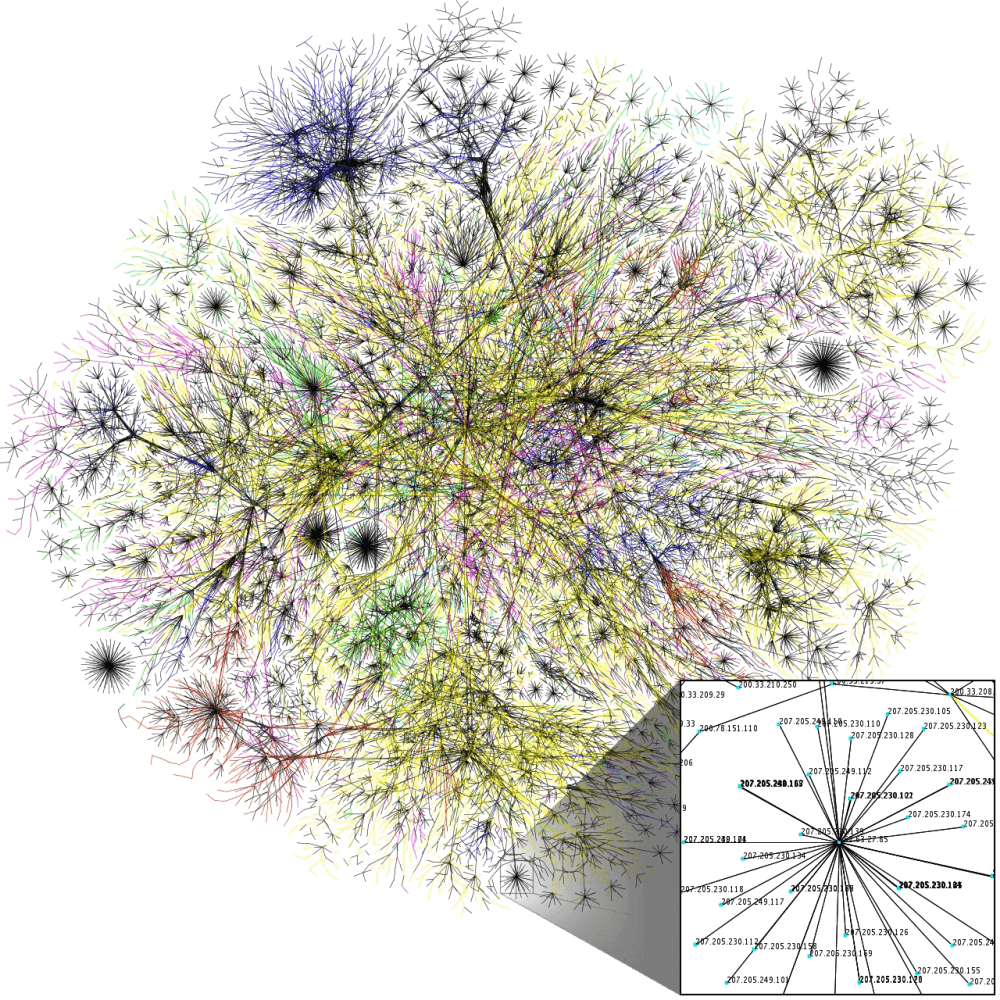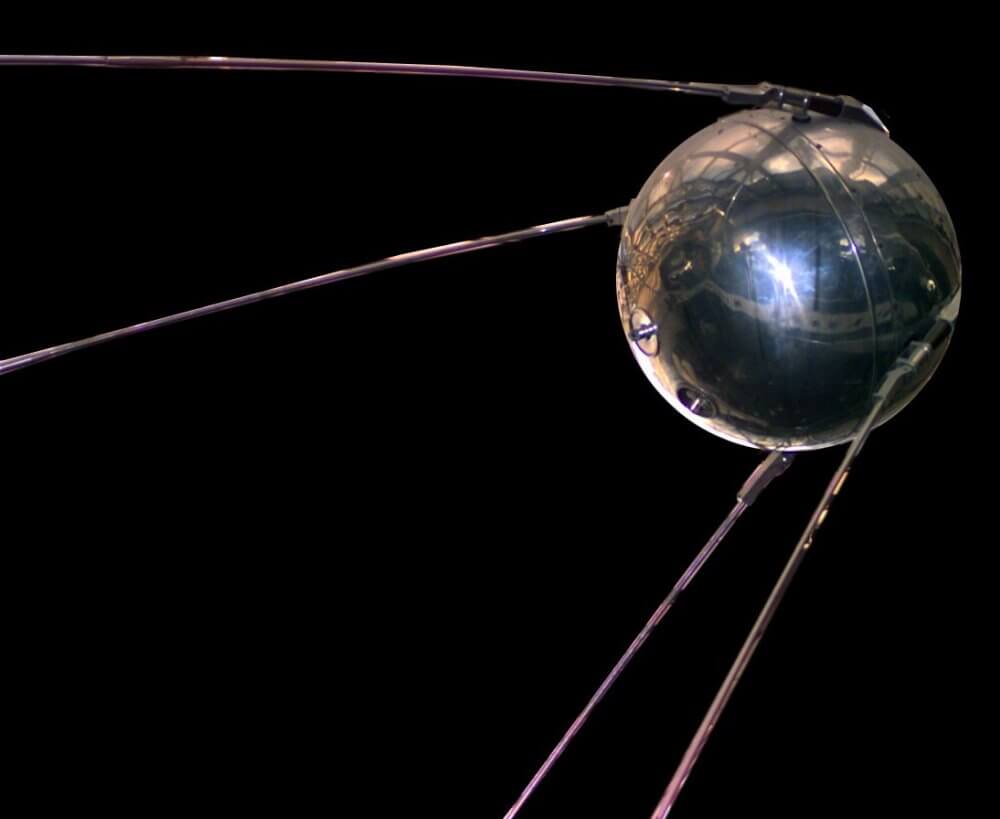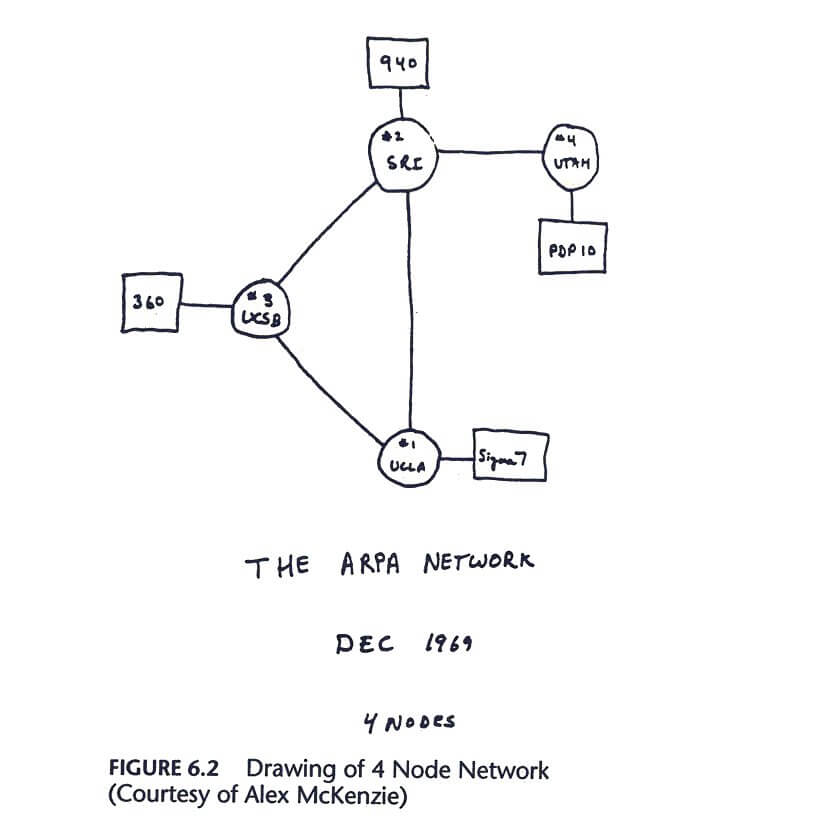Read Other People Texts on a Computer for Free

Permit's starting time by immigration upwards some mis-conceptions about the Internet. The Internet is non the Web. The Cyberspace is not a cloud. And the Internet is not magic.
It may seem similar something automatic that we take for granted, but at that place is a whole process that happens behind the scenes that makes it run.
So...The Net. What is it?
The Net is actually a wire. Well, many wires that connect computers all around the world.
The Internet is also infrastructure. It'southward a global network of interconnected computers that communicate through a standardised manner with set protocols.
Really, information technology'southward a network of networks. It's a fully distributed system of calculating devices and it ensures end to finish connectivity through every part of the network. The aim is for every device to be able to communicate with any other device.

The Internet is something we all utilize everyday, and many of us tin can't imagine our lives without it. The internet and all the technological advances it offers has changed our society. Information technology has changed our jobs, the style we consume news and share information, and the way we communicate with one another.
Information technology has also created so many opportunities and has helped helped humanity progress and has shaped our human experience.
There is nothing else like it – it's one of the greatest inventions of all time. But do we ever stop to call up why it was created in the first place, how information technology all happened, or past whom it was created? How the internet has become what information technology is today?
This article is more than of a journey back in time. We'll learn nearly the origins of the Internet and how far it has come throughout the years, every bit this can be beneficial in our coding journeys.
Learning about the history of how the Cyberspace was created has made me realise that everything comes down to problem solving. And that is what coding is all nigh. Having a problem, trying to find a solution to it, and improving upon it once that solution is found.
The Internet, a technology so expansive and e'er-changing, wasn't the work of merely i person or institution. Many people contributed to its growth by developing new features.
And then it has developed over time. It was at least 40 years in the making and kept (well, still keeps) on evolving.
And information technology wasn't created merely for the sake of creating something. The Internet we know and use today was a issue of an experiment, ARPANET, the precursor network to the internet.
And it all started considering of a problem.
Scared of Sputnik
It was in the midst of the Cold War, October 4 1957, that the Soviets launched the get-go man made satellite into space called Sputnik.
Equally it was the world's starting time ever artificial object to float into infinite, this was alarming for Americans.
The Soviets were not only ahead in science and engineering merely they were a threat. Americans feared that the Soviets would spy on their enemies, win the Common cold War, and that nuclear attacks on American soil were possible.

And so Americans started to think more seriously most science and technology. Later the Sputnik wake up call, the space race began. It was not long later that in 1958 the US Assistants funded various agencies, i of them being ARPA.
ARPA stands for Advanced Research Project Bureau. It was a Defence Department research project in Computer Science, a way for scientists and researchers to share information, findings, cognition, and communicate. It also immune and helped the field of Information science to develop and evolve.
It was there that the vision of J.C.R. Licklider, ane of the directors of ARPA, would offset to form in the years to come.
Without ARPA the Internet would non exist. It was because of this institution that the very commencement version of the Internet was created – ARPANET.
Creating a Global Network of Computers
Although Licklider left ARPA a few years earlier ARPANET was created, his ideas and his vision laid the foundation and building blocks to create the Cyberspace. The fact that it has go what we know today we may take for granted.
Computers at the time were not as we know them at present. They were massive and extremely expensive. They were seen as number-crunching machines and mostly as calculators, and they could but perform a limited number of tasks.
So in the era of mainframe computers, each one could but run a specific task. For an experiment to take place that required multiple tasks, it would require more than than one computer. Only that meant ownership more expensive hardware.
The solution to that?
Connecting multiple computers to the same network and getting those different systems to speak the aforementioned linguistic communication in lodge to communicate with one another.
The idea of multiple computers connected to a network was not new. Such infrastructure existed in the 1950'south and was called WANs (Broad Area Networks).
All the same, WANs had many technological limitations and were constrained both to small-scale areas and in what they could exercise. Each motorcar spoke it's ain language which made it impossible for it to communicate with other machines.
So this idea of a 'global network' that Licklider proposed and then popularised in the early 1960'southward was revolutionary. Information technology tied in with the greater vision he had, that of the perfect symbiosis between computers and humans.
He was certain that in the time to come computers would improve the quality of life and get rid of repetitive tasks, leaving room and time for humans to think creatively, more in-depth, and permit their imagination flow.
That could only come to fruition if different systems broke the linguistic communication barrier and integrated into a wider network. This thought of "Networking" is what makes the Internet nosotros use today. It's substantially the need for common standards for different systems to communicate.
Building a Distributed Packet Switched Network
Up until this indicate (the terminate of the 1960's), when yous wanted to run tasks on computers, data was sent via the telephone line using a method called "Circuit switching".
This method worked just fine for phone calls simply was was very inefficient for computers and the Internet.
Using this method you could only send data as a full packet, that is data sent over the network, and simply to one computer at a time. It was common for information to get lost and to have to re-start the whole procedure from the beginning. It was time consuming, ineffective, and costly.
And and then in the Cold War era, it was also dangerous. An assault on the phone arrangement would destroy the whole communication system.
The respond to that problem was bundle switching.
Information technology was a simple and efficient method of transferring data. Instead of sending information equally one large stream, it cuts information technology up into pieces.
Then it breaks downward the packets of data into blocks and frontward them as fast as possible and in every bit many possible directions, each taking its own different routes in the network, until they reach their destination.
One time there, they are re-assembled. That's fabricated possible because each packet has information about the sender, the destination, and a number. This then allows the receiver to put them dorsum together in their original form.
This method was researched by dissimilar scientists, but the ideas of Paul Baran on distributed networks were afterward adopted by ARPANET.
Baran was trying to figure out a communication system that could survive a nuclear attack. Substantially he wanted to discover a communication system that could handle failure.
He came to the determination that networks can be built around two types of structures: centralised and distributed.
From those structures at that place came 3 types of networks: centralised, decentralised, and distributed. Out of those three, it was just the last one that was fit to survive an attack.

If a office of that kind of network was destroyed, the rest of it would even so function and the job would just be moved to another function.
At the time, they didn't have rapid expansion of the network in mind – we didn't need information technology. And information technology was only in the years to come that this expansion started to take shape. Baran'south ideas were ahead of his time, nevertheless, they laid the foundation for how the Net works now.
The experimental packet switched network was a success. Information technology led to the early creation of the ARPANET architecture which adopted this method.
How ARPANET Was Congenital
What started off as a response to a Cold War threat was turning into something different. The get-go image of the Internet slowly began to take shape and the first calculator network was congenital, ARPANET.
The goal now was resources sharing, whether that was data, findings, or applications. It would allow people, no matter where they were, to harness the power of expensive computing that was far away, as if they were correct in front end of them.
Up until this signal scientists couldn't use resource available on computers that were in another location. Each mainframe computer spoke its own linguistic communication and so there was lack of communication and incompatibility between the systems.
In gild for computers to exist constructive, though, they needed to speak the same language and exist linked together into a network.
So the solution to that was to build a network that established communication links between multiple resource-sharing mainframe supercomputers that were miles apart.
The building of an experimental nationwide packet switched network that linked centers run by agencies and universities began.
On October 29 1969 dissimilar computers made their first connection and spoke, a 'node to node' communication from 1 figurer to another. Information technology was an experiment that was about to revolutionize communication.
The first ever message was delivered from UCLA (University of California, Los Angeles) to SRI (the Stanford Inquiry Plant).
It read simply "LO".
What was meant to be "LOGIN" was not viable at kickoff, as the system crashed and had to be rebooted. Just it worked! The showtime step had been made and the language bulwark had been broken.
Past the end of 1969 a connection had been established between four nodes on the whole network which included UCLA, SRI, UCSB (University of California Santa Barbara) and the University of Utah.

But the network grew steadily throughout the years and more and more universities joined.
By 1973 there were even nodes connecting to England and Norway. ARPANET managed to connect these supercomputing centers run past universities together into its network.
One of the greatest achievements of that time was that a new culture was emerging. A civilization that revolved around solving issues via sharing and finding the best possible solution collectively via networking.
During that time scientists and researchers were questioning every aspect of the network – technical aspects too as the moral side of things, too.
The environments where these discussions were taking place were welcoming for all and free of hierarchies. Everyone was free to limited their stance and interact to solve the large bug that arose.
We see that kind of civilization carrying over to the Internet of today. Through forums, social media, and the like, people ask questions to get answers or come together to deal with bug, whatever they may exist, that touch on the human status and experience.
Every bit time passed, more contained packet switched networks emerged that were non related to ARPANET (which existed on an international level and started to multiply past the 1970's) . That was a new challenge.
These different networks had their own dialects, and their own standards for how information was transferred. It was incommunicable for them to integrate into this larger network, the Internet we know today.
Getting these different networks to speak to one another – or Internetworking, a term scientists used for this process – proved to be a claiming.
A Need for Mutual Standards
At present our devices are designed so that they can connect to the wider global network automatically. Simply dorsum so this procedure was a complex job.
This worldwide infrastructure, the network of networks that we telephone call the Internet, is based on certain agreed upon protocols. Those are based on how networks communicate and exchange information.
From the early days at ARPANET, it nonetheless lacked a common language for computers exterior its ain network to exist able to communicate with computers on its own network. Even though information technology was a secure and reliable packet-switched network.
How could these early networks communicate with one some other? Nosotros needed the network to expand even more for the vision of an 'global network' to become a reality.
To build an open network of networks, a full general protocol was needed. That is, a set of rules.
Those rules had to be strict enough for secure data transfer but besides loose enough to accommodate all the ways that data was transferred.
TCP/IP Saves the 24-hour interval
Vint Cerf and Bob Khan began working on the design of what we now call the Internet. In 1978 the Transmission Control Protocol and Internet Protocol were created, otherwise known as TCP/IP.
The rules for the Interconnection were:
- The contained networks were non required to change
- In that location was an effort to achieve communication
- Internal networks would exist in addition with gateways that would connect these networks. Their job would exist to interpret between the networks. There would be one universal, agreed upon protocol for that.
- There would be no key control, no one person or organisation in charge.
As Cerf explained:
The job of TCP is simply to take a stream of letters produced by one HOST and reproduce the stream at a foreign receiving HOST without modify.
The Internet Protocol (IP) makes locating information possible when looking among the plethora of machines bachelor.
And then how does data travel?
So how does a packet go from ane destination to another? Say from the sending destination to the receiving ane? What role does TCP/IP play in this and how does it brand the journeying possible?
When a user sends or receives information, the first step is for TCP on the sender's machine to break that information into packets and distribute them. Those packets travel from router to router over the Internet.
During this time the IP protocol is in accuse of the addressing and forwarding of those packets. At the end, TCP reassembles the packets to their original state.
What Happened Adjacent with the Internet?
Throughout the '80s this protocol was tested thoroughly and adopted by many networks. The Internet merely continued to abound and scale at a rapid speed.
The interconnected global network of networks was finally starting to happen. Information technology was still mainly used widely by researchers, scientists, and programmers to exchange messages and information. The general public was quite unaware of it.
Merely that was virtually to change in the late '80s when the Internet morphed once more.
This was thank you to Tim Berners Lee who introduced the Web – how we know and use the Internet today.
The internet went from just sending messages from 1 computer to another to creating an attainable and intuitive style for people to browse what was at first a collection of interlinked websites. The Web was congenital on top of the Internet. The Internet is its courage.
I hope this commodity gave some context and insight into the origins of this galaxy of data we use today. And I promise you enjoyed learning almost how it really all started and the path it took to condign the Internet nosotros know and use today.
Learn to code for gratuitous. freeCodeCamp'south open up source curriculum has helped more than than 40,000 people get jobs as developers. Go started
Source: https://www.freecodecamp.org/news/brief-history-of-the-internet/